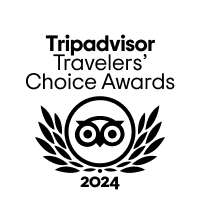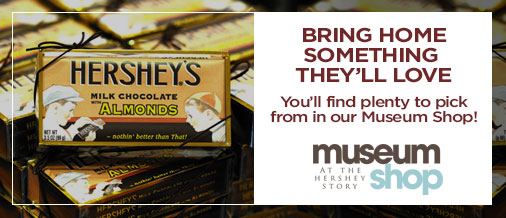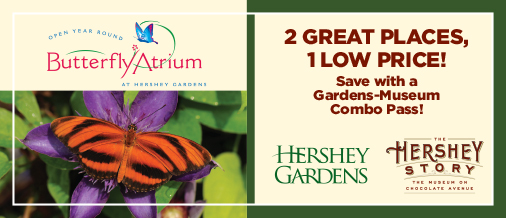Active, hands-on learning is at the center of the school programs at The Hershey Story.
Your students will love the fun way they’ll learn — and you’ll welcome our unique offerings that can’t be taught in a classroom.
For more information about the programs, please call Elizabeth Lindsay at 717.520.5588 or email [email protected]
 Education programs are supported by a grant from the Pennsylvania Historical and Museum Commission.
Education programs are supported by a grant from the Pennsylvania Historical and Museum Commission.
Special Exhibit Programs | Museum EduQuests | Gifted Programs
Chocolate Lab Interactives | Early Childhood Programs
Reservations: Make your reservations today; spaces fill quickly!
The Hershey Story school programs require a reservation for a minimum of 15 students, and can accommodate up to 100 students on the same day. Please note: student group rates are only available when a program is booked through the school.
Please make your reservation request here.
Museum EduQuests
Students explore the exhibits and enjoy the many interactive experiences throughout the museum on a variety of curriculum-themed hunts.
Time: Approximately 45 minutes
Cost: $11 per student, which includes museum admission
Add a Chocolate Lab class for $5 per student more!
Chaperones: One adult (including teachers) admitted free for every five students. A teacher must be present in the Museum Experience while students are participating in an EduQuest.
$13 per additional adult (EduQuest only; Chocolate Lab is restricted to students and chaperones only.)
A-B-See Quest
A picture is worth a thousand words! Pre-readers use colors, numbers, letters and shapes to explore The Hershey Story in this fast and fun program.
Grades: Preschool – 1st
Themes: Happiness for Life/Community; Change Over Time
Standards: Approaches to Learning (1.4, 2.1); Math (2.1); Personal/Social (3.2); Reading, Writing, Speaking and Listening (1.1, 1.3, 1.6); Geography (7.1)
Community Quest
Your class will explore the meaning of community and Mr. Hershey’s vision for his town through interactive technology and engaging stories.
Grades: Kindergarten – 2nd
Themes: Happiness for Life/Community; Change over Time
Standards: History (8.1, 8.3); Geography (7.3); Reading, Writing, Listening and Speaking (1.2)
Hershey Quest
Discover “Hershey” – the man, the town, and the business – through authentic artifacts and interactive technology. Travel with your students through five fascinating exhibits to uncover the many stories inside The Hershey Story.
Grades: 3rd – 6th
Themes: Happiness for Life/Community; Milton Hershey and Life Lessons
Standards: History (8.1, 8.2, 8.3); Geography (7.3); Reading, Writing, Listening and Speaking (1.2)
Geography Quest
Your class will travel through time from the farms of Pennsylvania to the Columbian Exposition in Chicago and the South American rain forests. Journey with them as they explore the town once called Derry Church, and discover its connection to the larger world. Soundscapes, computer interactives and creative theatres make the trip come alive.
Grades: 3rd – 6th
Themes: Connection to the Larger World, Change over Time
Standards: Geography (7.1, 7.2, 7.3); Reading, Writing, Listening and Speaking (1.2)
Economics Quest
How would you design the package of a candy of your own invention? Your students can do just that at our interactive stations, where they can explore and examine marketing materials, advertising techniques, and the power of packaging and design. Lessons in leadership and philanthropy are everywhere throughout our five exciting exhibit areas.
Grades: 7th – 12th
Themes: Milton Hershey and Life Lessons; Money/Economics/Entrepreneurship
Gifted Program
Developed with gifted classes in mind, this program will challenge students by leveraging their creativity and problem-solving skills.
Sweet Strategies: The Business of Selling Chocolate
Students will become immersed in the sweet business of selling chocolate in this hands-on, team-building class. First, teams will use real ingredients to create a new chocolate product. Next, they’ll design the packaging and then strategize a marketing campaign to sell their product. Instruction for the program will take place in the Chocolate Lab, Museum Experience and our classroom.
Themes: A program for gifted students grades 4-12
Standards: Reading, Writing, Listening and Speaking 1.1(F), 1.2(B), 1.6(C, E, F); Economics 6.2 (B, F), 6.5 (F, I); Career Education and Work 13.4(B, C)
Time: Approximately 2½ hours
Cost: $15 per student
Chaperones: One adult (including teachers) admitted free for every five students. A teacher must be one of the chaperones in the Chocolate Lab. Additional adults are not permitted in the Lab. They may purchase Museum Experience admission for $13 per adult.
Chocolate Lab Interactives
Chocolate making is a sweet recipe for learning about art and science! It is inspired by Milton Hershey’s own candy-making apprenticeship and his flair for experimentation. The Chocolate Lab explores the unique qualities of chocolate through educational, hands-on experiences on a variety of subjects including geography, history, economics and science. Students will make a chocolate creation in every Lab to take home.
Time: Approximately 45 minutes
Cost: $11 per student (unless otherwise noted)
Add a Museum EduQuest for $5 more per student
Chaperones: One adult (including teachers) admitted free for every five students. A teacher must be one of the chaperones in the Chocolate Lab.
Additional adults are not permitted in the Lab. They may purchase Museum Experience admission for $13 per adult.
Assembly Line Adventure
Students will thrive in this hands-on program as they are introduced to a variety of jobs in a chocolate factory. Students work together as a team to produce and package their own chocolate bars.
Grades: Kindergarten – 2nd
Themes: Connections to the Larger World; Lessons from Chocolate; Change Over Time
Standards: Social Studies (6.1, 6.5); Approaches to Learning ( 2.1, 2.3, 2.5); Personal Social (3H); Reading, Writing, Speaking and Listening 1.6, 3.7)
The Art of Chocolate
Students receive a rare look at a real cocoa pod, beans and nibs, and discuss the other ingredients of chocolate. After being introduced to the concept of liquids and solids, they will learn about the differences between milk, as well as dark and white chocolate. Students then create their own “abstract art” by using the melted chocolates to form a design.
Grades: Kindergarten – 2nd
Themes: Connection to the Larger World; Lessons from Chocolate
Standards: Reading, Writing, Listening and Speaking (1.1, 1.6); Mathematics (2.3); Science and Technology (3.4, 3.6); Geography (7.1); Family and Consumer Science (11.3)
Where in the World?
Using real cocoa beans from varying countries and continents, students can learn about the rich geography of cocoa and its connection to the larger world. Participants will taste samples of single-origin chocolates and be guided to distinguish the differences in taste. Students will make their own chocolate bars that may include unique ingredients such as cocoa nibs.
Grades: 3rd – 5th
Themes: Milton Hershey and Life Lessons; Money/Economics/Entrepreneurship; Connection to the Larger World; Lessons from Chocolate
Standards: Reading, Writing, Speaking and Listening (1.1, 1.6); Mathematics (2.3); Economics (6.4); Geography (7.1, 7.2, 7.3, 7.4); Food Science (11.3)
Chocolate in Central & South America
The Maya and Aztec cultures utilized cocoa beans in several unique ways long before people began making and consuming solid chocolate. Learn how cocoa beans were grown and processed to make a ceremonial chocolate drink and how they were even used as money. Students will try a chocolate drink similar to one the Mayans drank and make their own chocolate bar to take home.
Grades: 3rd – 6th
Themes: People, Places and Environment; Culture
Standards: History (8.1, 8.4); Geography (7.3, 7.4)
Chocolate in Colonial America
Step back in time and learn how chocolate was made in Colonial America and the unique ingredients that were used. Students try their hand at grinding cocoa beans and look at original recipes while discovering the important role chocolate played in the founding of America. Every student will make their own colonial inspired chocolate medallions that can be eaten or made into a special drink.
Grades: 3rd – 8th
Themes: Time, Continuity and Change; People, Places and Environments
Standards: History (8.1, 8.2, 8.3); Geography (7.3, 7.4)
Choconomics
Participants will be challenged to follow in Milton Hershey’s footsteps by designing their own candy bars. Choosing from a group of possible ingredients, they will construct a bar and cover it in tempered chocolate. Students will be introduced to basic economic theory as they analyze appearance, health value, cost and taste factors in making their choices.
Grades: 7th – 12th
Themes: Milton Hershey and Life Lessons; Money/Economics/Entrepreneurship; Lessons from Chocolate
Time: 1 hour
Standards: Economics (6.5); History (8.2); Food Science and Nutrition (11.3); Career Education and Work (13.4)
Flavor of Chocolate
Students will learn the steps to chocolate making, and sample both single origin and blended chocolates to learn how chocolate makers develop their delicious products. Students will also make their own chocolate creation to take home.
Grades: 7th – 12th
Themes: Chocolate
Time: 45 minutes
Standards: Speaking and Listening (1.5); Reading Informational Text (3.5); Basic Geographic Literacy (7.1); Physical Characteristics of Places and Regions (7.2); Food Science and Nutrition (11.3)
Temper, Temper
After a visual demonstration of the hand tempering process, students will be shown examples of tempered vs. untempered chocolate. Students will take a turn at hand tempering and create their own chocolate bar with their tempered chocolate. Through this fun and interactive lesson, high school students will be exposed to the complex topics of crystal formation and physical chemistry.
Ages: 9th – 12th Grade
Theme: Chocolate
Time: 1 1/2 – 2 Hours
Standards: Physical Science, Chemistry and Physics (3.4); Food Science and Nutrition (11.3)
Cost: $15 per student, which includes Lab experience OR
$20 per student, which includes Lab experience and Museum Experience admission
Chaperones: One adult (including teachers) admitted free for every five students. A teacher must be one of the chaperones in the Chocolate Lab.
Additional adults are not permitted in the Lab. They may purchase Museum Experience admission for $13 per adult.
Early Childhood Programs
Preschool: Ages 3 – 5
Early childhood programs are perfect for younger students, as they are introduced to visiting a museum and experiencing its educational resources.
Cost: $8 per student, per program – do both for $13!
Chaperones: One adult (including teachers) admitted free for every five children.
$13 per additional adult
Museum EduQuest: A-B-See Quest
A picture is worth a thousand words! Pre-readers use colors, numbers, letters and shapes to explore the museum in this fast and fun program.
Time: Approximately 30 – 45 minutes
A Community Built on Chocolate – Preschool
Young students learn about the resources and helpers that all communities need, with emphasis on Hershey, past and present. This interactive program engages young learners through stories, songs and a chocolate craft.
Time: Approximately 30 minutes


